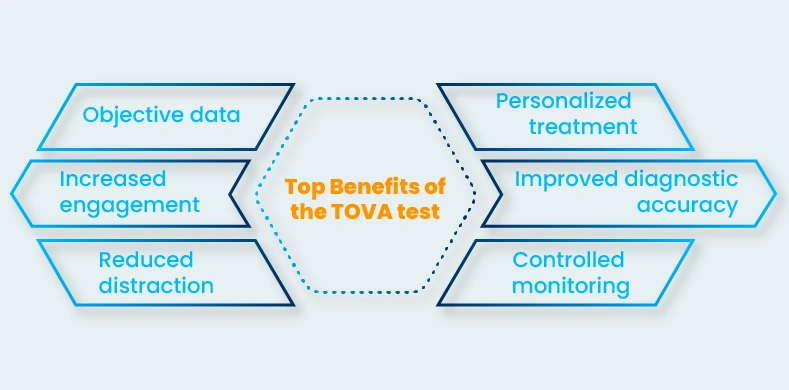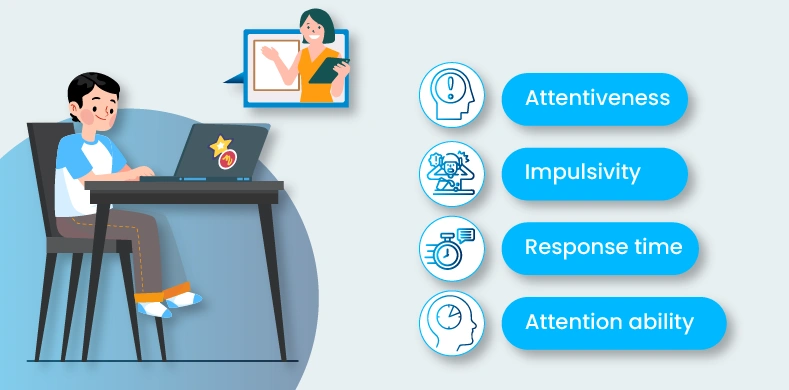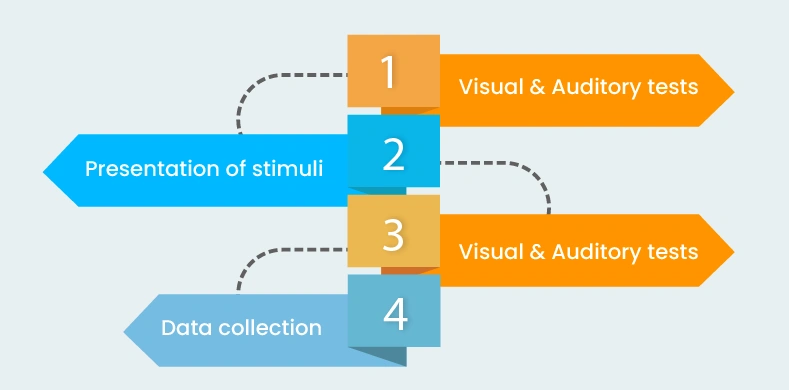Does your child have difficulty focusing in the classroom and get distracted easily? Does your child exhibit hyperactive and fidgeting behavior, and does not easily control their emotions? These signs indicate that your child is having ADHD (Attention Deficit Hyperactivity Disorder). Experts employ varied ways to diagnose ADHD, such as the TOVA test.
The TOVA (Test of Variables of Attention) is a significant computer-based neuropsychological test used to effectively diagnose and evaluate ADHD in individuals, including children, adolescents, and adults. To better assess ADHD, this test involves the quantifiable measurements of the child’s functional abilities, which include focus or attention, hyperactivity and impulsivity, and inhibitory control. This test is normally administered in a physical therapeutic setting. However, it can also work remotely for children. The integration of TOVA in virtual psychotherapy sessions assists the professionals in collecting valuable data on major ADHD indicators, which in turn helps in the development of early intervention or treatment plans.
This article provides complete and detailed information on the TOVA test, the method, and the significance of the administration of TOVA in virtual psychotherapy settings for ADHD diagnosis in children.
TOVA test & Virtual Psychotherapy for children
TOVA is a specialized medical device that plays an essential role in the determination of a child’s performance, which is not effectively gathered from other clinical examinations or behavioral ratings. With the help of the TOVA test, experts can get detailed information about children’s attention-related abilities. TOVA is considered an international standard for ADHD evaluation. This continuous performance test (CPT) is also approved by the FDA, MDEL Canada, European MDD, and Australian TGA.
ADHD is a common neurodevelopmental disorder that involves the symptoms of inattention, hyperactivity, and increased impulsivity. This mental illness affects all individuals, including children and adults. Recent studies have reported that approximately 11.4% of children whose age is between 3 and 17 have been diagnosed with Attention Deficit Hyperactivity Disorder. Children with ADHD have to face multiple issues due to their inattentive nature, hyperactive behavior, excessive fidgeting, and low impulse control. These ADHD symptoms negatively interfere with their life functioning.
Focus or attention is the major factor that can exert a major impact on cognitive abilities and ultimately life. If you want to get an idea of how your child experiences the world or sees the world, then you should first understand how his or her attention works. Healthcare providers benefit from this insight and provide timely support and intervention to manage ADHD and navigate the resulting life challenges.
Benefits of Virtual Psychotherapy and the TOVA Test for ADHD children
The TOVA test performed in a virtual setting offers numerous benefits, including ease and flexibility of scheduling the test. The virtual administration is ideal for those children who usually feel nervous in physical settings,or parents are unable to physically meet the experts due to multiple physical restrictions. Without going anywhere, children can take this test from the comfort of their home.
There is a strong connecting link between TOVA and virtual psychotherapy for children. As this test helps in effective evaluation of ADHD in children, after confirmation, experts decide whether they should offer the virtual psychotherapy or not or what kind of modes they can use to employ the virtual psychotherapy interventions for children.
The Top Benefits of the TOVA test in virtual settings include:
- Objective data
- Increased engagement
- Reduced distraction
- Personalized treatment
- Improved diagnostic accuracy
- Controlled monitoring

What does TOVA measure in children?
The TOVA test measures the following things:
Attentiveness
This test estimates the ability to focus for an extended period.
Impulsivity
This comprises the ability of how quickly a child responds to stimuli.
Other important skills or abilities that TOVA measures include:
- Response time
- Variability in time response
- Attention ability, or performance

Is the Tova test reliable for ADHD evaluation in children?
Yes, the TOVA test is considered a reliable diagnostic tool for ADHD in children. The main underlying reason that indicates its reliability is that it provides standardized evidence. Multiple studies have reported that children suffering from ADHD exhibit different responses to this test as compared to those who do not have ADHD, which clearly explains the validity or reliability of these tests.
But various researchers have suggested that relying only on this tool is not appropriate. The accuracy of the TOVA test in the identification of individuals with hyperactive ADHD is 90%, while the ratio is 87% for individuals without ADHD. Likewise, multiple studies have also reported that TOVA is used to identify individuals with non-hyperactive ADHD, whose percentage accounts for 84%.
How does the TOVA test work for children?
The TOVA test is offered in two different formats:
- Visual
- Auditory
Normed for Ages that range from 4 to 80+
TOVA visual test: The visual test of TOVA is normed for the age group from 4 to 80. For individuals who are 17 or older, this involves the embedded performance validity measurement. For preschool-aged children, this includes the short test.
TOVA auditory test: This norm is for individuals whose age ranges from 6 to 29.
TOVA for children
The duration of TOVA tests varies for each child depending on their age. For children who are 6 years or older, the duration of the TOVA test is 21.6 minutes. While for the children whose age is 4 or 5, this test takes approximately 10.8 minutes.
Key steps that how TO specifically works for Children
The following are the main steps that indicate how TOVA works for ADHD assessment in children:

Visual & Auditory tests
The visual and auditory tests help in the evaluation of varied aspects of focus or attention.
Presentation of stimuli
The child is then exposed to multiple visual or auditory signals that are presented on the computer screen or with the help of speakers in a controlled setting.
Response to stimuli
After receiving the stimuli via different modes, children utilize a microswitch to show a response to the stimuli.
Data collection
With the help of the TOVA test, the following things are measured:
Child’s response time:
The duration during which a child shows a response to the external signals
Response time variability
This involves the measurement of the consistency of response time.
Omission errors
This measures the time that how many times the child exhibits a response to the main target stimuli. The omission errors help in the determination of inattentiveness issues.
Commission errors
Commission errors involve the determination of time and how many times the child shows the response to the non-target signal. This is an indication of impulsivity.
Comparison to Norms
After the data collection, the child’s performance is then compared with the normative sample of children who fall under the same age or gender category. This helps the professionals to get a complete insight into their ability to focus, attention, hyperactivity, impulsivity, and other related ADHD factors. Experts carefully analyze each aspect of the collected data and craft a complete, comprehensive.
What are the major signs that indicate that your child should be tested for ADHD?
The following are the major signs that indicate your child is battling with ADHD and needs to be tested for ADHD:

- Difficulty in focus or attention
- Increased impulsivity
- Increased hyperactivity
- Emotional instability
- Negative behavioral changes
- Poor academic performance
- Difficulty in maintaining relationships
- Aggressive behavior
Find the Professional TOVA testing at Children’s Psych
If your child is suffering from ADHD and you are looking for reliable TOVA testing near me, then your search should stop at the Children Psych. At Children Psych, we offer a wide range of mental health services to treat all common psychiatric issues in children and adolescents. We have a team of ADHD experts who are skilled in diagnosing and treating ADHD in children and adolescents. They employ highly advanced diagnostic tools such as TOVA for the appropriate ADHD assessment. After completing the process of evaluation, they develop personalized treatment plans that cater to the individual needs of each child.
Step ahead and schedule a consultation with our ADHD evaluation experts and help your child live an ADHD free, healthier, and fulfilled life.
Frequently Asked Questions
What is the main purpose of the TOVA test?
The TOVA test is used for the objective measurement of attention and impulse control in ADHD individuals, including children.
How does an ADHD computer test work?
The ADHD computer tests, such as TOVA, function to measure the ability of attention, hyperactivity, and impulsivity in response to environmental signals.
What are the four main components of attention?
The four major attention components involve maintaining attention, adjusting attention, selective attention as well and situational awareness.
Can ADHD testing be performed through virtual modes?
Yes, ADHD testing can be performed through telehealth or virtual services.




